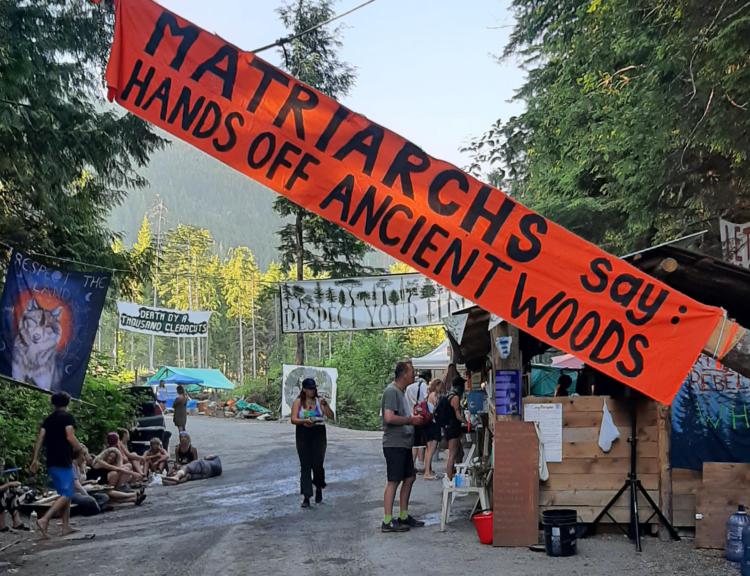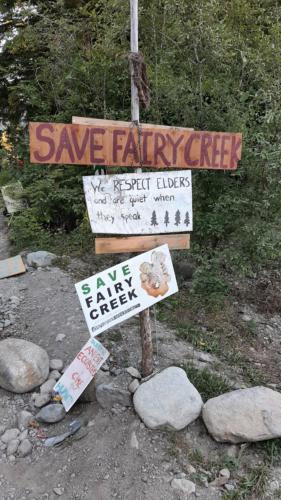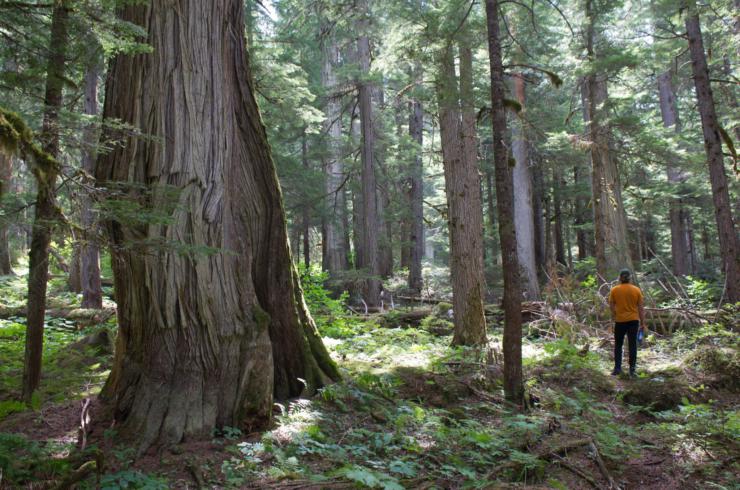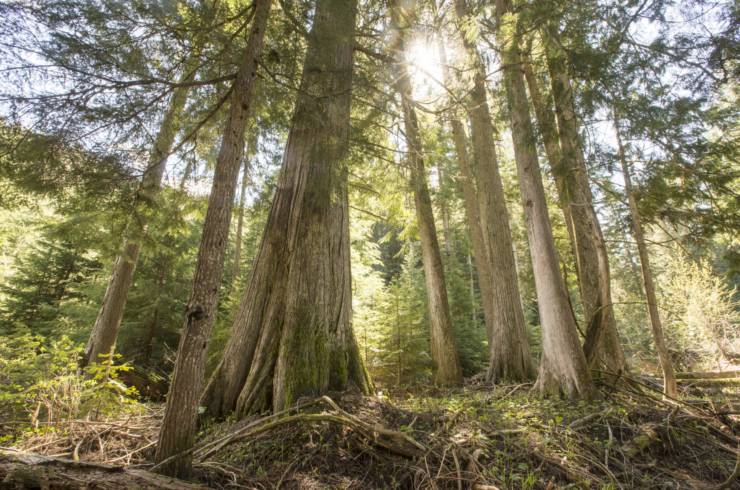By Lindsay Cuff
Director, Wildsight Regional Council
“A tree is the slow explosion of a seed.” ~Bruno Munari
My eight-year-old son and I pull up to the access gate on the Forest Service Road (FSR) just off Pacific Marine Rd. One of the forest defenders greets us and we tell her we’re planning to stay the night and help out at blockade HQ. She reads a land acknowledgement and hands us a five-page document written by the Rainforest Flying Squad about creating inclusive spaces at camp. My son reads the first few paragraphs out loud, looks at me with pleading eyes in the 35 degree heat, and we ask if we can take it with us to read later. The forest defender gives us the OK and we make our way up the FSR to the “gravel pit.” There are a few tents and parked cars scattered here and there. There is a shelter in the middle with red dresses hanging around its perimeter — a memorial for the missing and murdered Indigenous women.


I set up our tent and we walk over to the HQ afternoon meeting. After another land acknowledgement and some stretching and spinal roll-downs, we choose our camp names and sign up for a six-hour “runner” shift the next morning. I’m impressed with the overall organization at camp. And even though it is sometimes awkward and not quite fully developed in its expression, I’ve never seen inclusion and diversity centered at any old growth protest I’ve ever been to. I was 13 when the Clayoquot protests took place almost 30 years ago (and couldn’t find anyone in the Bible belt town I grew up in to take me), but I went to many old growth protests in my twenties — in the Walbran, in the Carmanah, at the legislature. I have wrapped my arms around ancient yellow cedars and instinctively known that they held ecological and spiritual stories beyond my understanding.
We leave the afternoon meeting as the mosquitoes start to pick up and take a dip in Fairy Creek. We talk to another forest defender who tells us about the action that took place that afternoon. A group of people, including families with young children, attempted to hike into Avatar Grove to protest the exclusion line put in place by the police to limit access to the more remote blockade camps. There was confusion among the protesters about where the line was and, as people found themselves thrust into a situation they weren’t expecting, including use of excessive force by the police, they were alarmed and scared. The forest defender tells me there were 14 arrests that afternoon.

I dive back into the cold water of the creek and try to wash off the sweat and dust, as well as an uneasy feeling.
We take a walk up the blockade road and every person we pass greets us with eye contact, a smile and hello. I take some pictures of the colourful protest signs flanking the road and my son points out a large outhouse structure made of wood and sticks with a hand-painted blue accessibility sign tacked to the door. Not far from the outhouse, we see a garden perched on a slope that is being created as an offering for Indigenous peoples who come to the blockade. The relationship between the Fairy Creek blockade and the local Pacheedaht Nation is fraught. They are supported by Pacheedaht Elder Bill Jones, but have been asked to leave the territory by the elected Chief.
When we get back to the gravel pit, people are gathering in a large circle near the sheltered gathering spot to debrief the day. Forest defenders take turns sharing their experiences from the afternoon and there is a lot of emotion. The group is silent as an Indigenous woman speaks about looking out for each other — about circling up, not just for safety reasons, but also for emotional support.
I go to bed and around midnight am woken up by conversations happening near our tent. One of the young women who was arrested that day is sharing her experience with a friend. Someone else says she is worried about another friend, a teenager, who was arrested that day — she still hasn’t heard whether or not she’s been released.
I can’t sleep. My feeling of uneasiness is increasing and it’s becoming clear that the tension between both sides of this new war in the woods is building — heightened by the heat, by the last year and a half spent in a global pandemic, and by the sheer length of this protest, which has been going on for almost a year.
We wake up at dawn the next day, do our six-hour safety shift and take a final swim. Although I’m leaving the blockade with questions about how to forge a path forward that does not pit one side so vehemently against the other, I am heartened by the spirit of inclusion and diversity I’ve witnessed. This is a big step forward for the environmental movement.
It’s clear that we need to take urgent action to protect our ancient forests, not just on the coast, but also in the interior. Since the blockade has started north of Revelstoke to defend old growth in the Inland Temperate Rainforest, I’ve been inspired by the insistence on kindness and compassion, the emphasis on communication and a just transition for local economies, and by the support of Indigenous Nations. Read the Splatsin statement on the blockades and the Ktunaxa Nation statement on Argonaut.
I’ve come away from Fairy Creek with an even deeper belief that it is our responsibility, as settlers on this land, to actively decolonize our forestry practices, to incorporate Indigenous knowledge and to let Indigenous peoples make decisions about their land and how it is stewarded.
I know it is not easy to change an entire paradigm, but I do believe it is possible. A tree is the slow explosion of a seed. Let’s keep showing up, planting the seeds, working together to do the hard work of creating the future we want our children to inherit.










